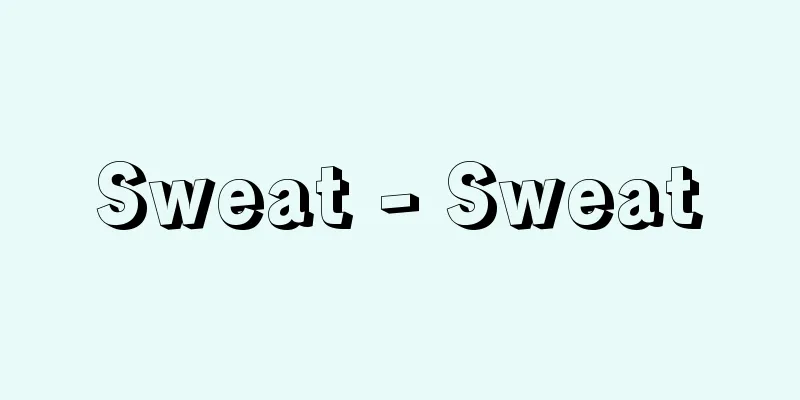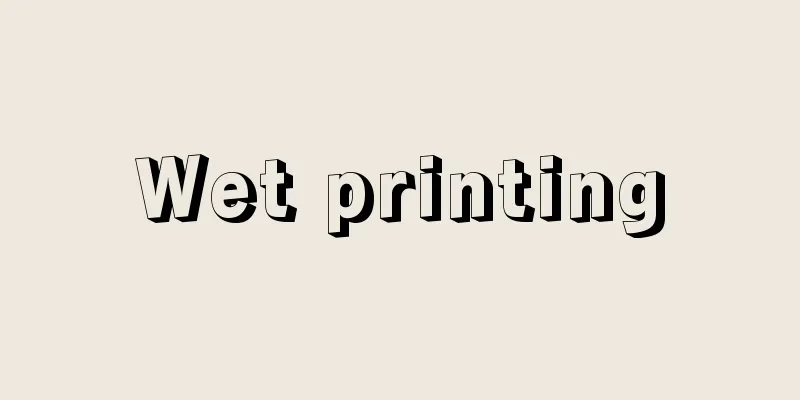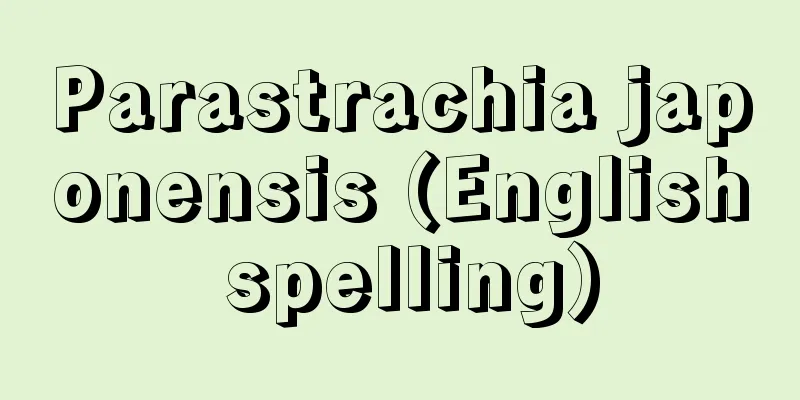Sweat - Sweat

|
It is a secretion from the sweat gland. It is more than 99% water, the rest is mostly salt, and also contains urea and lactic acid. In other words, sweat can be said to be a dilute salt water solution. It is also the dilutest of all secretions. The salt concentration varies significantly depending on the degree of sweating, ranging from 0.3 to 0.9%, and is usually about 0.65%, but the more you sweat, the higher the concentration becomes, reaching 0.9%. This is because when secreted, the salt concentration close to that of the body fluids is reabsorbed in the sweat gland ducts, and when a large amount of sweat is released, reabsorption does not occur sufficiently. The amount of sweat secreted is 600 to 700 cc per day, but in midsummer, when doing physical labor or strenuous exercise, it can reach 10 liters. At such times, a considerable amount of salt is lost from the body, so it is necessary to replenish salt along with water. In addition, the salt concentration of sweat is extremely low in people who live permanently in tropical regions, and people who always have a high salt concentration are prone to heat stroke. The main function of sweat, together with sebum, is to prevent the skin from drying out and to keep its surface normal, and the most important function is to regulate body temperature by dissipating heat of evaporation. The skin dissipates 70-80% of the body's heat. The secretion of sweat from sweat glands is called sweating. Sweating can be divided into thermal sweating and psychological sweating based on its cause. Thermoregulation is sweating that is involved in thermoregulation and occurs when the temperature is high or when heat production is increased due to muscular exercise. This sweating occurs all over the body except the palms of the hands and the soles of the feet. A sudden rise in temperature or humidity makes people more likely to sweat, and the same temperature stimulus makes people more likely to sweat in summer than in winter. Children sweat in a similar manner in both spring and summer, but adults sweat more in summer and approach the amount of sweating that occurs in children. Children's body surface area is large compared to their body weight, and a large amount of sweat evaporates and takes away heat, so this is not seen in adults, but since body temperature drops during sweating, it is necessary to keep warm while sleeping, especially in spring. Psychogenic sweating occurs due to mental or sensory stimuli and appears only on the palms of the hands, soles of the feet, and under the arms. This is what is referred to as "sweaty hands" or "cold sweat" regardless of the outside temperature. Psychogenic sweating moistens the palms of the hands and soles of the feet, making it easier to move the hands and feet, and is the same as spitting on your hands when you are about to start heavy labor. Sweating is suppressed by applying pressure to the skin, and is called hemisweating. When pressure is applied to one side of the body, sweating on that side is suppressed and sweating on the other side is increased. For this reason, it is effective to sleep on your side in summer. Sweating on the face can also be caused by taste stimuli such as sour or spicy tastes, and is called gustatory sweating. While the incubation period for thermal sweating is long, that of psychological sweating is short, and sweating occurs immediately, so it is also used in lie detectors. In general, even when thermogenic sweating is so intense that sweat is pouring out, the addition of mental stimulation suppresses sweating. This phenomenon occurs when a person becomes engrossed in something and forgets the heat. For example, during the July sumo tournament, it is often observed on television that wrestlers do not sweat as much during the match, but sweat profusely before standing up and after the match. Also, when the whole body is sweating, cooling a part of the body, for example by dipping both feet in a bucket of cold water or cooling the back of the neck, suppresses sweating over the whole body. Sweat glands are divided into apocrine glands and eccrine glands based on their secretion pattern. Sweat is a secretion from the eccrine glands distributed throughout the body. The number of sweat glands in Japanese people is between 2 and 5 million, but the number of active sweat glands that actually secrete sweat is between 1.8 and 2.75 million, and they are most densely distributed on the palms of the hands and the soles of the feet, followed by the forehead. The degree of sweating varies from person to person, with some people barely sweating at all and others said to sweat a lot. This is partly a sensory aspect, but is mainly due to the excitability of the sweating center in the brain. The sweating center is located in the spinal cord, and the higher center is the hypothalamus at the base of the diencephalon, which connects with other autonomic nervous functions and regulates body temperature. The excitability of the sweating center also increases during exercise, sleep, and after fever has subsided. Increased sweating during exercise is due to the excitement of the center as well as an increase in sweat secretion due to an increase in blood volume. Sweating during sleep is a common occurrence in young children, but is also a common experience in adults. If the room temperature is high, thermal sweating of the entire body is induced by sleep, and psychological sweating is reduced. This is because the sweat inhibition center, which has an inhibitory effect on the thermo-sweating center, and the mental sweating center, which is constantly stimulated by mental functions while awake, both relax during sleep, and the thermo-sweating center becomes more sensitive. For this reason, regardless of room temperature, palm sweating stops during sleep, so if your palms are not dry, you are falling asleep. Also, if for some reason the sensitivity of the sweating center is increased to the point where you do not sweat while awake, sleep will further increase its sensitivity, causing so-called night sweats. Thermal sweating begins several days after birth, while mental sweating begins between 1 and 3 months of age. This is understood as the development of the central nervous system progresses from the lower part (diencephalon) to the higher part (cerebral cortex). Although sweat glands are innervated by sympathetic nerves, the nerve fibers are cholinergic like the parasympathetic nerves, and secretion is inhibited by atropine and promoted by pilocarpine. [Hidenobu Mashima] "The Story of Sweat" by Yasushi Kuno (1963, Koseikan) [Reference items] | | | |Source: Shogakukan Encyclopedia Nipponica About Encyclopedia Nipponica Information | Legend |
|
汗腺(かんせん)からの分泌物をいう。99%以上が水で、残りの大部分は食塩、ほかに尿素や乳酸などが含まれる。つまり汗は希薄な食塩水ともいえる。また諸分泌液中でもっとも希薄な液体である。食塩濃度は0.3~0.9%で発汗の程度によって著しく異なり、普通は約0.65%であるが、大量に発汗するほど濃くなって0.9%にも達する。これは、分泌時に体液の食塩濃度に近いものが、汗腺の導管内で再吸収されるわけで、汗が大量に流れた場合には再吸収が十分に行われなくなるためである。汗の分泌量は1日600~700ccであるが、盛夏、筋肉労働や激しい運動をすると10リットルにも達する。このようなときは体外に失われる食塩もかなりの量になるので、水とともに食塩の補給も必要である。なお、熱帯地方の永住者では汗の食塩濃度がきわめて低く、また、いつも食塩濃度が高めの人は熱射病にかかりやすい。 汗のおもな機能は、皮脂とともに皮膚の乾燥を防ぎ、その表面を正常に保つほか、とくに重要なものは蒸発熱の放散による体温の調節である。皮膚からの体熱の放散は全体の70~80%にも達する。 汗腺から汗を分泌することを発汗という。発汗はその原因から温熱性発汗と精神性発汗に分けられる。 温熱性発汗は体温調節に関与する汗で、気温の高いときや筋肉運動によって熱産生が高まったときにおこる。この発汗は手のひらや足の裏を除く全身におこる。急に温度や湿度が高くなると発汗しやすく、また同じ温度刺激でも夏季は冬季より発汗しやすい。小児では春、夏ともに似たように発汗するが、成人は夏季になると発汗量が多くなり、小児の発汗量に近づく。小児の体表面積は体重に比して大であり、多量の汗が蒸発して熱を奪うため、成人ではみられないが、体温が発汗中に下がるので、とくに春季には睡眠中に適度の保温が必要となる。 精神性発汗は精神的または感覚的刺激によっておこり、手のひら、足の裏、わきの下だけに現れる。外界の温度には関係なく、手に汗を握るとか、冷や汗をかくといわれるものがこれである。精神性発汗により手のひらや足の裏に湿りを与えて手足の働きを容易にするということは、力仕事などに着手しようとするとき手に唾(つば)するのと同じ意味をもつ。 発汗は皮膚を圧迫すると抑制されるが、とくに半側発汗といい、体の左右どちらか一側に圧迫を加えると、その側の発汗が抑制され、他の半側の発汗が増進する。このことから、夏季就寝時には横向きに寝るのが効果的といえる。また、酸味や辛味などの味覚刺激によっても顔面に発汗がみられることがあり、味覚性発汗とよばれる。なお、温熱性発汗の潜伏期は長いが、精神性発汗のそれは短く、すぐに発汗がおこるので、うそ発見器にも利用される。 一般に、汗が流れ出るほど温熱性発汗が盛んなときでも、精神的刺激が加わると発汗が抑制される。夢中になると暑さを忘れるという現象である。たとえば、大相撲の7月場所で、力士が勝負中はそれほどでなく、立ち上がる前や勝負後に盛んに汗を流すことは、テレビでよく観察される。また、全身に発汗しているとき、体の一部を冷却、たとえば両足をバケツの中の冷水につけたり、首の後ろを冷やすと、全身の発汗が抑制される。 汗腺はその分泌様式からアポクリン腺とエクリン腺に分けられる。いわゆる汗は全身に分布するエクリン腺の分泌物である。汗腺の数は日本人では200万~500万であるが、実際に汗の分泌を行う能動汗腺は180万~275万で、その分布は手のひらと足の裏にもっとも密で、ついで前額に多い。 発汗の程度には個人差があり、ほとんど汗をかかない人から、汗かきといわれる人まである。これは感覚的な面もあるが、主として脳の発汗中枢の興奮性によるものである。発汗中枢は脊髄(せきずい)にあり、上位中枢は間脳底部の視床下部で、ここで他の自律神経機能と連絡し、体温調節が行われている。また発汗中枢は、運動中、睡眠中、解熱後に興奮性が高まる。運動中に発汗量が増すのは、中枢の興奮のほか、血液量の増大によって汗の分泌量が増加することにもよる。また睡眠中に汗をかくのは、幼児では日常的にみられるが、成人でもよく経験する。室温が高ければ全身の温熱性発汗は睡眠によって誘発され、精神性発汗は減退する。これは、温熱性発汗中枢に抑制的な作用を及ぼしている発汗制止中枢と、精神機能によって覚醒(かくせい)中、絶えず刺激されている精神性発汗中枢は、ともに睡眠中にはその緊張が解けるので温熱性発汗中枢のほうは感受性が高まることになるためである。このことから、室温とは関係なく、睡眠中は手のひらの発汗が止まるので、手のひらが乾いていなければ、狸(たぬき)寝入りということになる。また、なんらかの理由で覚醒中は発汗しない程度に発汗中枢の感受性が高められているときは、睡眠によって一段と感受性が高まり、いわゆる寝汗をかくことになる。 温熱性発汗は出生後数日から始まり、精神性発汗は1~3か月から始まる。これは、中枢の発達が低級部分(間脳)から高級部分(大脳皮質)に進むことから理解される。 なお、汗腺の神経支配は交感神経であるが、神経線維は副交感神経と同じコリン作動性であり、アトロピンにより分泌が抑制され、ピロカルピンによって促進される。 [真島英信] 『久野寧著『汗の話』(1963・光生館)』 [参照項目] | | | |出典 小学館 日本大百科全書(ニッポニカ)日本大百科全書(ニッポニカ)について 情報 | 凡例 |
>>: Asuncion (English spelling)
Recommend
Nightshade - Nightshade
An annual plant of the Solanaceae family (APG cla...
Adachi family
…After the implementation of the Jōkyō calendar i...
Inflammatory kyphosis
…It is often seen in the thoracic spine, and depe...
Kosmas Indikopleustēs
A merchant from Alexandria in the 6th century. Dat...
Akhdar Mountains - Akhdar Mountains (English spelling)
Although there is a mountain range of the same nam...
Hokuriku Expressway - Hokuriku Expressway
An expressway that runs along the Sea of Japan ...
comedy of situation
...The characters with comical personalities (mis...
Clavier
Klavier is a German term for keyboard instruments ...
Caramel - Caramel (English spelling)
A type of soft candy, it is softer and chewier th...
Neotragus moschatus (English spelling)
…[Tadaaki Imaizumi]. … *Some of the terminology t...
Reverse correspondence - Gyakutaio
…Also, for each element b in B , define a subset ...
Origin of the family
...However, in its original form, the main family...
Georges Ferdinand Bigot
French painter. Born in Paris, he studied at the ...
Church-affiliated school
…The so-called Carolingian Renaissance flourished...
Hida County Magistrate - Hidagundai
During the Edo period, this was one of the local o...









